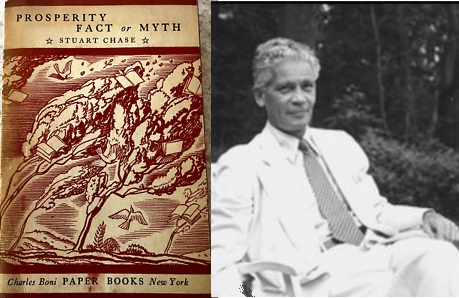|
| |
Stuart Chase, Prosperity: Fact or Myth (1929)
Just before the Crash – the American economist and social theorist Stuart Chase wrote: Prosperity: Fact or Myth. You can read the book here - though you will probably find it is heavy-going/skim-reading stuff … perhaps at most read pages 29-31, 35-38 and the last Chapter, and dip into other chapters if you think they look interesting. Chase finds large numbers of people who have NOT benefited from the boom, and that – even for those who have benefited – 'prosperity' includes a downside (e.g. debt, or a more pressured way of working, the pressure of keeping up with the Joneses, or a world where a household now NEEDS money, and can no longer 'get by', producing enough itself to support itself).
What is 'prosperity', he asks, and finds that different meanings provide different outcomes:
***
|
Stuart Chase (1888-1985) was a respected economist a social theorist. Prosperity: Fact or Myth is still referenced by modern historians and writers, including Maury Klein (2003), Kathleen G Donohue (2006) and Gary Best (2017).
|
A Conclusion:“We have let us say an onion. The onion represents the total economic life of the United States at the present time. The heart of the onion is prosperity. How large does it bulk?
First, we must strip off all the states not included in the Middle Atlantic, East North Central, and Pacific states. The National Bureau of Economics finds that by and large these states have not prospered. Second, in the prosperous belt, we strip off most of the farmers; they have not prospered. Third, we strip off a large section of the middle class. The small business man, the independent storekeeper, the wholesaler, many professional men and women, have failed to keep income on a par with the new standard of living. Fourth, we strip off the unemployed. Machinery appears to be displacing factory, railroad, and mining workers – and recently mergers are displacing executives, salesmen and clerks – faster than they can find employment in other fields. The net increase in "technological unemployment" since 1920 exceeds 65o,000 men and women. Fifth, we strip off the coal industry which has been in the doldrums throughout the period. Sixth, we strip off the textile industry which has been seriously depressed. Seventh, the boot and shoe industry. Ditto. Eighth, the leather industry. Ninth, the shipbuilding industry. Tenth, the railroad equipment industry. Eleventh, we strip off the excessive number of businesses which have gone bankrupt during the era. Twelfth, we strip off those millions of unskilled workers who were teetering on the edge of a bare subsistence in 1922, and by no stretch of the imagination can be called prosperous to-day. The best that can be said is that their position is a little less precarious than it was. In short only a part of the country has been prosperous...
The onion has shrunk, but it has not disappeared. We shall not list all the surviving leaves, but among the significant are :
1. A 20 per cent increase in the national income per capita from 1922 to 1928. 2. A 30 per cent increase in physical production. 3. A 200 per cent increase in the profits of the larger corporations. 4. A housing program expanding faster than population. 5. An increase in average health and longevity. 6. An increase in educational facilities greatly surpass-ing the growth of population. 7. A per capita increase in savings and insurance. 8. A booming stock market up to October 1929. 9. A 5-hour decline in the average working week. 10. A slowly rising wage scale against a fairly stationary price level. 11. An increasingly productive, alert and intelligent science of management, resulting primarily in an ever growing productivity per worker."
|
Have You Realised?... that all Chase's examples of the failures of
Prosperity involved PEOPLE, but all his list of Propserity's successes are
STATISTICS.
|
|
| |
